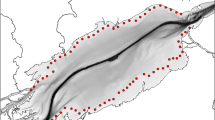Abstract
This study examines the relationships between fish, environmental variables and submerged macrophytes within the irrigation system of the lower valley of the Río Colorado in southern Argentina. Using Canonical Correspondence Analysis (CCA), the strongest environmental gradients detected were conductivity and carp ( Cyprinus carpi) biomass per unit area of channel cross-section. These variables were positively associated with each other and also with water turbidity. Sites scoring high on these gradients were mainly drainage channels; those scoring lowest were irrigation channels. The main fish species associated with high carp biomass, high turbidity and high conductivity were carpa ( C. carpio), pejerrey ( Odontesthes bonariensis), madrecita ( Jenynsia lineata lineata) and lisa ( Mugil liza). Dientudo ( Oligosarcus jenynsi) and mojarra ( Astianax eigenmanniorum) were more strongly associated with clearer water, with low carp biomass. In all CCA analyses macrophytes were arranged in similar order along the main conductivity-turbidity-carp biomass gradient. Lowest on this main environmental gradient, and scoring very close to each other, were Potamogeton pectinatus and Chara contraria. Salinity-tolerant species such as Ruppia maritima, Zannichellia palustris and Enteromorpha flexuosa tended to score highest, followed by the surface floating Azolla filiculoides and the filamentous alga Cladophora surera. Within the constraints imposed by conductivity, turbidity was a key predictor of both abundance and distribution of the two dominant plants of the irrigation scheme ( P. pectinatus and C. contraria). Turbidity was strongly predicted by biomass of carp per unit channel cross sectional area, when fine sediment particle content was taken into account. The positive association between carp biomass and water turbidity was both substantial and predictable, and was in turn associated with reduction in submerged plant growth. The biomass of the most widespread nuisance-causing plant species in the channels, Potamogeton pectinatus, could best be predicted ( R = 0.592, P < 0.05) using a multiple regression model utilising four predictor variables: conductivity, nitrate, phosphate and carp biomass.
Similar content being viewed by others
References
Alikunhi, K. H., 1966. Synopsis of biological data on common carp Cyprinus carpio Linnaeus, 1758 (Asia and the Far East). FAO Fish. Synops. (31.1): pag.var.
Bregazzi, P. R., J. C. J. Domaniewski & J. G. W. Jones, 1984. Carp Farming Project: Final Report to Ministry of Agriculture, Fisheries & Food. University of Reading, Reading, UK 75 pp.
Breukelaar, A. W., E. H. R. R. Lammens, J. G. P. Klein Breteler & I. Tátrai, 1994. Effects of benthivorous bream (Abramis brama) and carp (Cyprinus carpio) on sediment resuspension and concentrations of nutrients and chlorophyll a. Freshwat. Biol. 32: 113–121.
Cazzaniga, N. J., 1981. Caracterización químico faunísticas de canales de drenaje del Valle Inferior del Rio Colorado. Ecosur 8: 24–46.
Cline J.M., T. L. East & S. T. Threlkeld, 1994. Fish interactions with the sediment-water interface. Hydrobiologia 275/276: 301–311.
Fernández, O. A., J. H. Irigoyen, M. R. Sabbatini & O. Svachka, 1987a. Recomendaciones para el control de Potamogeton striatus y Chara contraria en distritos de riego. ASAM Malezas 15: 5–44.
Fernández, O. A., J. H. Irigoyen, M. R. Sabbatini & R. E. Brevedan, 1987b. Aquatic plant management in in drainge canals of southern Argentina. J. Aquat. Plant Mgmt 25: 65–67.
Hootsmans, M. J. M. & J. E. Vermaat, 1991. Macrophytes, a key to understanding changes caused by eutrophication in shallow freshwater systems. IHE Report Series 21. IHE, Delft, The Netherlands. 412 pp.
Lamarra, V., 1975. Digestive activities of carp as a major contributor to the nutrient loading of lakes. Verh. int. Ver. Limnol. 19: 2461– 2468.
López Cazorla, A., 1987. Contribución al conocimiento de la ictiofauna marina del área de Bahía Blanca. PhD Thesis. Facultad de Ciencias Naturales y Museo. La Plata-Argentina, 247 pp.
Murphy, K. J., 1995. Aquatic Weeds. In Encyclopedia of Environmental Biology, Academic Press, San Diego, USA, 1: 71–80.
Murphy, K. J. & J. W. Eaton, 1983. Effects of pleasure-boat traffic on macrophyte growth in canals. J. appl. Ecol. 20: 713–729.
Murphy, K. J., R. G. Hanbury & J. W. Eaton, 1981. The ecological effects of 2-methylthio triazine herbicides used for aquatic weed control in navigable canals. I. Effects on aquatic flora and water chemistry. Arch. Hydrobiol. 91: 294–331.
Ringuelet, R. A., R. H. Aramburu & A. Alonso de Aramburu, 1967. Los peces argentinos de agua dulce. Comisión de Investigación Científica. Com. Invest. Cient., La Plata. 600 pp.
Sdabbatini, M. R., 1989. Biología y manejo deChara contraria A. Braun ex Kütz. MS Thesis, Universidad Nacional del Sur, Bahia Blanca. 102 pp.
Sarig, S., 1966. Synopsis of biological data on common carp Cyprinus carpio Linnaeus, 1758 (Near East and Europe). FAO Fish. Synops. (31.2): pag.var.
Sidorkewicj, N. S., A. C. López Cazorla & O. A. Fernández, 1996a. The interaction between Cyprinus carpo L. and Potamogeton pectinatus L. under aquarium conditions. Hydrobiologia 340: 272–275.
Sidorkewicj, N. S., A. C. López Cazorla, M. R. Sabbatini, O. A. Fernández, K. J. Murphy & J. C. J. Domaniewski, 1996b. La carpa comun (Cyprinus carpio L.) como posible agente de biocontrol de malezas acuaticas sumergidas en canales de drenaje. In V SICONBIOL Simposio de Controle Biologico, Brasil 1996, 55.
Sidorkewicj, N. S., A. C. López Cazorla, K. J. Murphy, M. R. Sabbatini, O. A. Fernández & J. C. J. Domaniewski 1997, in press. Field experiments on the interaction of common carp (Cyprinus carpio L.) with aquatic macrophytes in Argentine drainage channels. J. Aquat. Plant Mgmt.
ter Braak, C. 1988. CANOCO — a FORTRAN program for canonical community ordination by [partial][detrended][canonical correspondence analysis, principal components analysis and redundancy analysis. Version 2.1. Technical Report LWA–88–02, GLW, 6700 AC Wageningen, The Netherlands. Microcomputer Power, Ithaca, New York.
Threlkeld S. T., 1994. Benthic-pelagic interactions in shallow water columns: an experimentalist's perspective. Hydrobiologia 275/276: 293–300.
Tur, N. M., 1982. Revisión del géneroPotamogeton L. en la Argentina. Darwiniana 24: 217–265.
Author information
Authors and Affiliations
Rights and permissions
About this article
Cite this article
Fernández, O.A., Murphy, K.J., López cazorla, A. et al. Interrelationships of fish and channel environmental conditions with aquatic macrophytes in an Argentine irrigation system. Hydrobiologia 380, 15–25 (1998). https://doi.org/10.1023/A:1003215513435
Issue Date:
DOI: https://doi.org/10.1023/A:1003215513435




